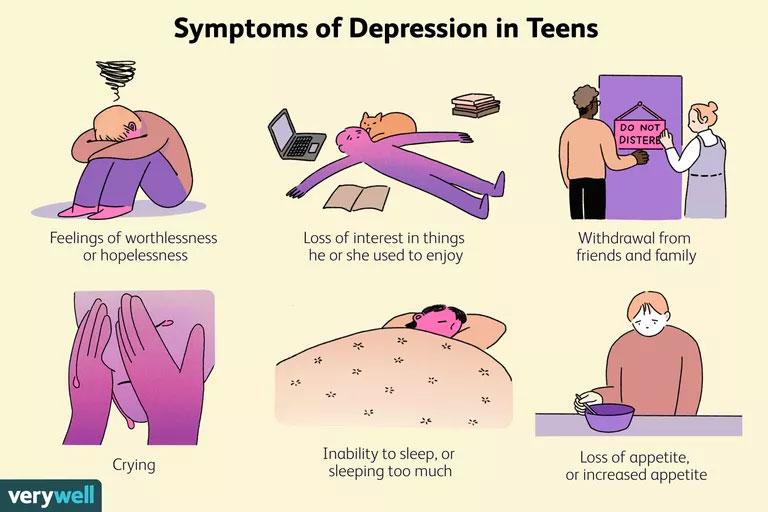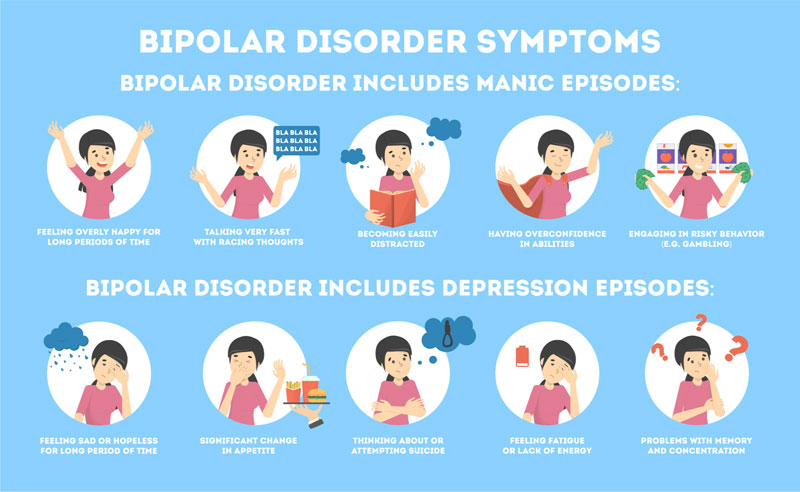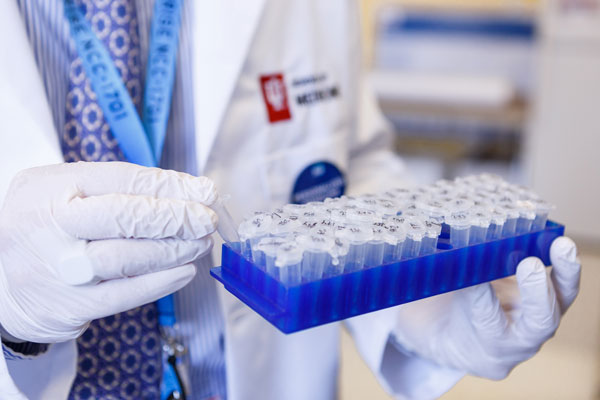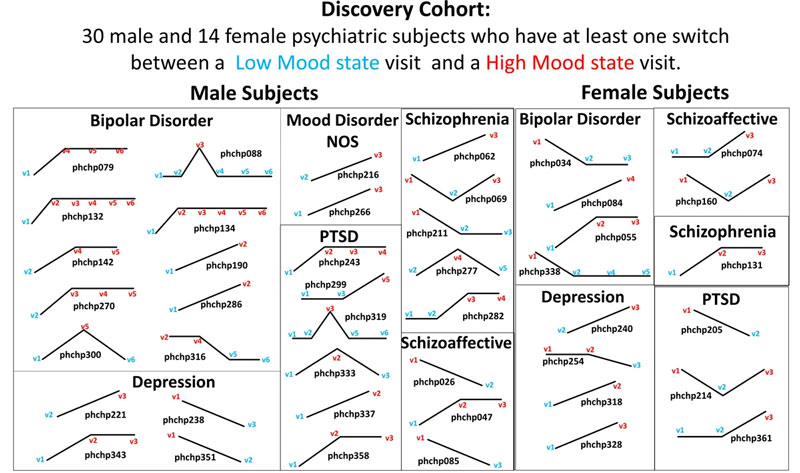Highlights
Most psychiatric conditions are diagnosed by talking with patients about what they are experiencing with no diagnostic testing such as blood tests or imaging studies. These researchers looked for biomarkers in blood that can predict depression and bipolar disorder. They found six biomarkers that could indicate or predict both depression and mania. These biomarkers are being used to determine specific medication(s) to treat individual patients.
How are you feeling right now? Are you happy or sad? Anxious or calm? Stressed or relaxed? Maybe you are feeling multiple emotions at once, or maybe none. Our
moods
can be finicky, changing from moment to moment, and difficult to describe. There are normal fluctuations in mood that we all experience during the day and over the course of our lives. Sometimes, though, changes in mood can start to negatively impact our ability to do our daily activities and actively participate in our relationships. When this happens, we can experience what are known as
mood disorders.
Scientists and clinicians have words to describe mood disorders that affect how we live our lives, like
depression
or
anxiety disorder.
Some mental illnesses such as
bipolar disorder
and
schizophrenia
include depression and anxiety as symptoms.
How are psychiatric conditions diagnosed? Most psychiatric conditions are diagnosed primarily by talking with patients about what they are experiencing. This is distinct from other areas of medicine, where talking with patients is one piece of diagnosis, supplemented by specific information about the body obtained through diagnostic testing such as blood tests or imaging studies.
For Dr. Alexander Niculescu, the reliance on a patient’s experience to determine a psychiatric diagnosis shows just how little is known about our minds and bodies and how they work together: “I love to study the brain and mind because we know so little and there is so much to explore,” he remarked. Dr. Niculescu, Professor of Psychiatry and Medical Neuroscience at Indiana University School of Medicine, has been researching the human mind for over two decades. The goal of his research is to develop better tools (such as blood tests) to help clinicians diagnose and treat mental illnesses. In recent research, Dr. Niculescu and his team have identified certain markers in the blood that can indicate depression and bipolar disorder.
Depression and Bipolar Disorder
Depression affects
more than 264 million people of all ages
and is one of the most common mental illnesses. It is characterized by low mood in addition to other symptoms such as loss of pleasure or interest in things one used to enjoy, feelings of hopelessness or worthlessness, difficulty sleeping or concentrating on tasks, and changes in weight or appetite, among
others.
While there are several types of depression, the most common is
major depressive disorder,
which is the focus of Dr. Niculescu’s study.

Figure 1. Symptoms of depression in teenagers
[Source: https://www.verywellmind.com/teen-depression-3200844]
It is important to note that there is a difference between feeling “depressed” now and then versus clinical depression. Feelings of occasional sadness or depression are common and can be normal. Clinical depression refers to a specific medical condition that can be diagnosed and treated. The most common treatment options for depression are
psychotherapy
and medications.
Depression can be a mental illness in and of itself, and it can also be a symptom of other conditions, such as bipolar disorder. Bipolar disorder is characterized by noticeable changes in mood and energy between low periods (depression) and high periods (mania).
Mania
refers to a state of abnormally high mood where the patient may be unusually active with racing thoughts and little need for sleep. Manic states can be very dangerous because they can involve an increase in risky behavior, including spending sprees and gambling.
There are three types of bipolar disorder that differ in the duration and severity of depressive and manic episodes. Until a patient has a manic episode, it can be difficult for clinicians to distinguish between major depressive disorder and bipolar disorder. This can have negative consequences for patients because the treatments for depression and bipolar disorder are distinct. “A blood test that could help us differentiate between these two disorders with different treatment options would be incredibly beneficial to patients,” remarked Dr. Niculescu.

Figure 2. Symptoms of bipolar disorder
[Source: https://www.portstluciehospitalinc.com/bipolar-disorder-symptoms-causes-and-treatment/]
The Search for Biomarkers
Dr. Niculescu imagines a world in which you can go to your doctor with mental health symptoms, and your doctor can supplement the information you share about your mood with diagnostic tools, such as a blood test, to help make a diagnosis and determine the most appropriate course of treatment. To make this possible, the first step is knowing what to look for. This is where Dr. Niculescu began his research two decades ago.
The idea to look for markers of mental illness in the blood was new when Dr. Niculescu began his research. “It was not at all obvious that what we were doing might work,” Dr. Niculescu recalled. Dr. Niculescu hypothesized that specific markers of mental illness might be detectable in the blood because of the ways the brain and body are connected through the
immune system
and
stress response.
Biomarkers
are indicators of a biological state (like a disease or infection) that can be measured such as in samples of urine, blood, or
cerebrospinal fluid,
the fluid that surrounds the brain and spinal cord.

Figure 3. Small tubes for samples
[Source: Indiana University]
A biomarker can be a protein, enzyme, or piece of genetic material (such as
RNA),
among others. For example, when your doctor orders a basic metabolic panel, your blood is drawn and tested for biomarkers including glucose (sugar), electrolytes (such as sodium and potassium), and an enzyme that indicates liver function.
When searching for biomarkers of mental illness, Dr. Niculescu chose to start in the blood because it is readily available and easy to obtain. Dr. Niculescu decided to look for RNA biomarkers because RNA measures how much of a given gene is being expressed, called gene expression.
To begin looking for RNA biomarkers in the blood, Dr. Niculescu and his team designed a process to identify candidate biomarkers and determine which were most appropriate. This process involves three independent
cohorts
of patients and has been used to identify biomarkers for conditions such as
pain disorders
and
Alzheimer’s disease.
In a recent series of experiments, Dr. Niculescu used this process to identify biomarkers for depression and bipolar disorder. The process consists of the following steps: discovery, prioritization, validation, and testing.
Discovery, Prioritization, and Validation
The first phase of the process is called discovery. The goal of discovery is to identify potential biomarkers. In this phase, Dr. Niculescu knew that he was looking for pieces of RNA in the blood that would be related to the course of illness of patients with depression and bipolar disorder. However, he did not know which particular RNA sequences might end up as biomarker candidates. Thus, he followed patients over time so they could be observed in different mood states.
A total of 44 patients, 30 men and 14 women, agreed to participate in the study. The initial testing visit took place in the laboratory or an inpatient psychiatric unit, where patients participated in interviews and gave a blood sample. The clinicians conducting the interviews used a variety of tools to measure depression and mania including the Hamilton Rating Scale for Depression, the Young Mania Rating Scale, and a visual analog scale.
Different information is obtained from each of these scales. The Hamilton Rating Scale for Depression indicates level of depression by asking questions about symptoms such as depressed mood, feelings of guilt, and thoughts of suicide on a scale of 0 (absent) to 4 (extreme). The Young Mania Rating Scale measures mania by asking questions about symptoms such as elevated mood, increased activity, and changes in sleep, on a scale of 0 (absent) to 4 (extreme). Both the Hamilton Rating Scale for Depression and the Young Mania Rating Scale are conducted through spoken interviews with the patient and filled out by the interviewer.
In contrast, the visual analog scale quantifies mood states so that a patient’s reported mood can be compared from visit to visit. It asks seven questions about mood, motivation, and activity level and is filled out directly by the patient.
Patients completed these interviews and gave blood samples for up to six subsequent testing visits that were 3-6 months apart, or sooner if the patient was hospitalized.
By following this group of patients over time, Dr. Niculescu accumulated many data points and possible biomarkers for depression and mania.

Figure 4. Discovery cohort analysis over time. The Phchp### is the study identification number for each participant. The V# denotes the visit number.
[Source: Figure 1 from Le-Niculescu et al. 2021. Molecular Psychiatry. https://doi.org/10.1038/s41380-021-01061-w]
The research team analyzed changes in gene expression when patients had low mood states (depression) and high mood states (mania) using two approaches: absent-present and differential expression.
Absent-present refers to genes that were present in one mood state and completely absent in another mood state. Differential expression refers to genes that were present in both low and high mood states but differed in the amount of expression. Dr. Niculescu and his team identified 11,620 RNA sequences across 9,649 unique genes that differed in expression between low and high mood states using either of these methods.
To determine which possible gene candidates warranted further testing, Dr. Niculescu turned to the scientific literature to see what evidence existed to support the relevance of particular RNA sequences to mental illness in human or animal studies. This was the prioritization phase of the process.
These sequences became candidates of study in the next series of experiments, called the validation phase. A total of 6,370 sequences across 4,960 unique genes moved forward for validation.
The participants in the validation study included patients from the discovery phase who reported low mood and/or high mood but did not have clinically severe symptoms. In addition, 47 new patients who had not been involved in the discovery phase participated, 30 who had clinically severe depression (23 men and 7 women) and 17 who had clinically severe mania (16 men and 1 woman).
Dr. Niculescu and his team compared their data with large databases developed from previous studies in the field. Analysis from these results yielded 26 top gene expression candidates that could serve as biomarkers for further study in patients with depression or mania. These biomarkers were tested in separate groups of people in the next phase of the study, called the testing phase.
Testing
In the testing phase, Dr. Niculescu and his team sought to test the ability of each of the top 26 gene candidates to predict who was experiencing a mental illness and who might experience a mental illness in the future. They did this by studying four outcomes:
- Mood state (as measured by the visual analog scale)
- Depression (as measured by the Hamilton Rating Scale for Depression)
- Mania (as measured by the Young Mania Rating Scale)
- Future hospitalization due to either depression or mania
The gene candidates were tested in eight separate groups of psychiatric patients. A total of 1,284 patients participated across the eight groups, which included:
- Low mood (as measured by the visual analog scale)
- Clinical depression (as measured by the Hamilton Rating Scale for Depression)
- Hospitalization due to depression within the first year after initial visit
- Hospitalization due to depression after the first year of initial visit
- High mood (as measured by the visual analog scale)
- Clinical mania (as measured by the Young Mania Rating Scale)
- Hospitalization due to mania within the first year after initial visit
- Hospitalization due to mania after the first year of initial visit
At the end of the testing phase, Dr. Niculescu and his team identified the top six blood biomarkers that could indicate or predict both depression and mania: NRG1, DOCK10, GLS, PRPS1, TMEM161B, and SLC6A4. By following these biomarkers Dr. Niculescu and his team were able to predict the severity of a patient’s illness, and the risk of illness in the future.
This biomarker information can also be used to determine which medication(s) can help each individual patient. This is part of a new field called
precision medicine
or personalized medicine.
Next Steps
Together, this series of experiments supports Dr. Niculescu’s original hypothesis that it is possible for biomarkers in the blood to be used in the diagnosis and treatment of mental illness. Dr. Niculescu believes that diagnostic testing is important to support clinicians, improve patient outcomes, and reduce the stigma of mental illness. “When there is a test that allows patients to see that their illness is not ‘just in their heads,’ it allows patients to feel more hopeful, less ashamed, and more willing to seek out treatment.”
In addition to future work translating the laboratory findings into diagnostic tests, Dr. Niculescu plans to continue looking for biomarkers for other mental illnesses such as schizophrenia. His team is also looking for biomarkers that might indicate the early development of mental illness to aid in the prevention of mental illness before it develops. Finally, Dr. Niculescu hopes to expand his research to include adolescents in addition to adults.
Dr. Niculescu has used a similar process to identify biomarkers for conditions such as anxiety disorders, pain disorders, and stress disorders, among others. Dr. Niculescu is working to translate his laboratory findings into clinical tests for doctors and patients through the company he co-founded, called MindX Sciences.
If you think you or someone you know might be experiencing a mental illness, you are not alone. Reach out to a trusted adult in your life, a counselor, or a medical professional to get the support you need.
Dr. Alexander Niculescu, III is Professor of Psychiatry and Medical Neuroscience at Indiana University School of Medicine and Founder of MindX Sciences. He has spent his career researching biomarkers and developing new diagnostic tools for mental illnesses, and he is a pioneer in the field of precision medicine for psychiatric illnesses. When not in the laboratory, Dr. Niculescu enjoys soccer, martial arts, and meditation.
For More Information:
- Le-Niculescu, H., et al. 2021. “Precision medicine for mood disorders: objective assessment, risk prediction, pharmacogenomics, and repurposed drugs,” Molecular Psychiatry. https://doi.org/10.1038/s41380-021-01061-w
To Learn More:
Precision Medicine for Mental Illness
- Blood test for depression, bipolar disorder. https://www.sciencedaily.com/releases/2021/04/210408112310.htm
- Laboratory of Neurophenomics. http://www.neurophenomics.info
- MindX Sciences. https://mindxsciences.com/
- What is Precision Medicine. https://medlineplus.gov/genetics/understanding/precisionmedicine/definition/
Depression
- CDC. https://www.cdc.gov/childrensmentalhealth/depression.html
- National Institute of Mental Health. https://www.nimh.nih.gov/health/topics/depression
- National Alliance on Mental Illness. https://www.nami.org/About-Mental-Illness/Mental-Health-Conditions/Depression
- National Helpline. https://www.samhsa.gov/find-help/national-helpline
Bipolar Disorder
- National Institute of Mental Health. https://www.nimh.nih.gov/health/topics/bipolar-disorder
- National Alliance on Mental Illness. https://www.nami.org/About-Mental-Illness/Mental-Health-Conditions/Bipolar-Disorder
- Psychology Today. https://www.psychologytoday.com/us/basics/bipolar-disorder
Written by Rebecca Kranz with Andrea Gwosdow, PhD at www.gwosdow.com
HOME | ABOUT | ARCHIVES | TEACHERS | LINKS | CONTACT
All content on this site is © Massachusetts
Society for Medical Research or others. Please read our copyright
statement — it is important. |

